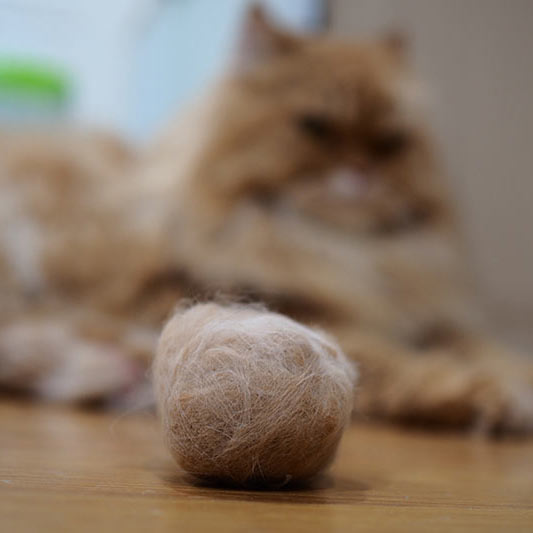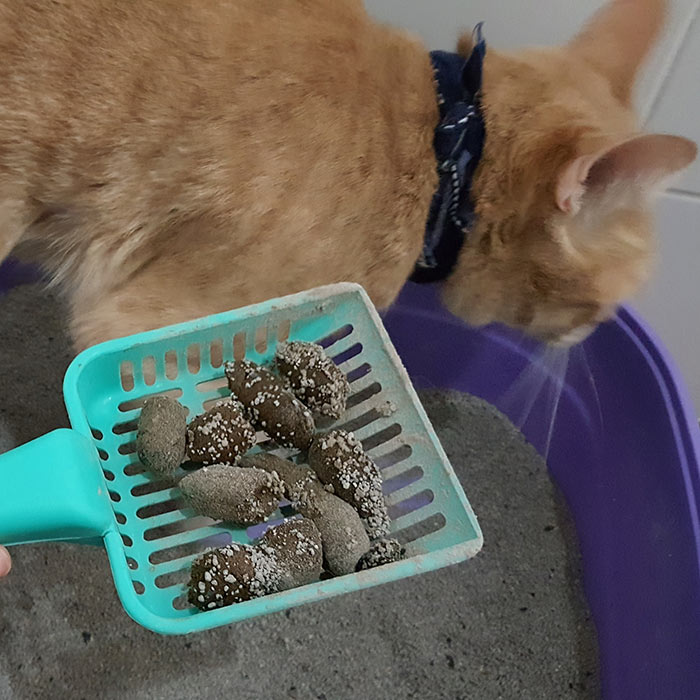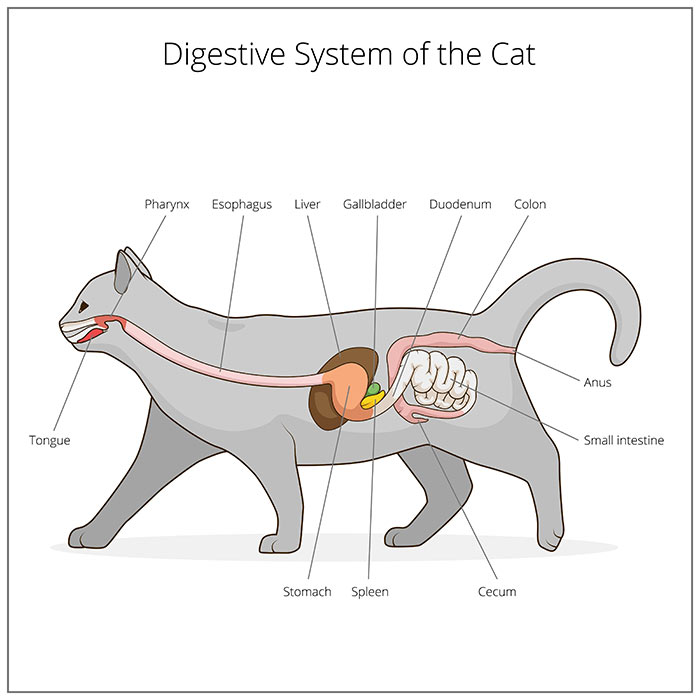Megacolon in cats
What is megacolon?
Megacolon is a relatively common disorder in which a cat’s colon, or large intestine, becomes distended and enlarged. The enlarged colon, unable to function properly, cannot evacuate the stool and becomes filled with hard and dry faeces. This may occur as a primary disease, typically caused by colonic muscles that do not contract normally, or as a secondary to prolonged or severe constipation, that has irreversibly stretched and enlarged the colon.
Constipation refers to the infrequent or incomplete evacuation of faeces, which are typically dry and hard. As the faeces remain in the colon longer, they become even drier, harder, and more difficult to pass. The term “obstipation” refers to prolonged and severe constipation, with permanent loss of colonic motility (i.e. the colon loses the ability to move the stool through it). The colon can be impacted with hard, dry faeces along its entire length, from the rectum to the ileocolic valve. When obstipation results in the chronic dilation and enlargement (hypertrophy) of the colon, the condition is referred as megacolon. Megacolon in cats is characterised by hypomotility (“slow movement”), which refers to the abnormal deficiency of propulsive forces that are required to ‘push’ the faeces through the colon.
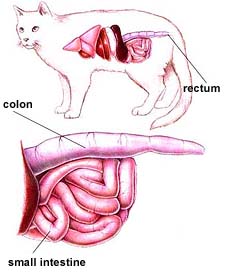 Normal colon in cats. Megacolon in cat. Cat constipation.
Normal colon in cats. Megacolon in cat. Cat constipation.
Source: http://vetnetwork.net/pca/articles/digestive/images/f_normalcolon.jpg
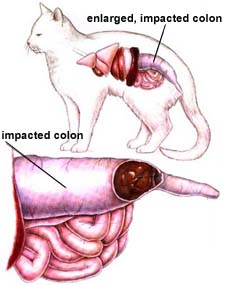
Megacolon in cat. Cat constipation.
Source: http://vetnetwork.net/pca/articles/digestive/images/f_impaction.jpg
Symptoms of megacolon in cats
The symptoms found in cats with constipation, obstipation and megacolon are similar, and will depend on the severity of the condition.
Cats affected by megacolon may show the following signs:
- Abdominal discomfort;
- Decreased appetite;
- Lethargy;
- Straining to defecate and tenesmus (a continual or recurrent inclination to evacuate the bowels);
- Painful defecation;
- Failure to defecate or reduced defecation;
- Hard, dry stool, possibly containing blood;
- Small amounts of liquid faeces after straining;
- Frequent visits to the litter box, with little result;
- Defecation outside the litter box;
- Diarrhoea in some cases;
- Vomiting, in some cases;
- Weight loss;
- Dehydration;
- Urinary incontinence (where there are pelvic or nerve injuries).
Causes of megacolon in cats
There are many causes of, and contributing factors to, constipation, obstipation and megacolon. However, in almost two-thirds of cases, the condition is termed “idiopathic megacolon” because the cause is unknown (Source: petcoach).
Possible causes include:
- An abnormality in the smooth muscle of the colon;
- A narrowing of the pelvic area (often due to pelvic fractures);
- Nerve injury;
- Spinal cord deformities, especially in Manx cats;
- Colonic inertia (hypomotility);
- Colonic obstruction, for example from poorly healed pelvic fractures;
- Rarely, the cause and/or contributing factors can include cancer, tumours, hernias of the rectum/anus and inflammation.
Constipation, obstipation and megacolon can occur in cats of any age, breed and gender, however, there are a number of risk factors associated with these conditions, including:
- Middle age – these conditions are more commonly found in cats from 5 to 9 years old.
- Domestic Shorthair, Domestic Longhair and Siamese cats are more prone (Source: VetFolio).
- Male cats appear to be twice as likely to develop these conditions as females.
- A sedentary lifestyle may contribute to the development of constipation, and ultimately megacolon.
- Obesity may adversely affect the course of the disease.
How is megacolon in cats diagnosed?
Diagnosis of megacolon is relatively straight-forward. The veterinarian usually detects a faeces-filled large intestine during the physical exam, and abdominal X-rays confirm that the colon is enlarged. Additional diagnostic tests are necessary to determine if megacolon has developed in response to an underlying condition.
Physical examination
The diagnosis of constipation, obstipation and megacolon is usually based on the history as well as results of a physical examination. On palpation of the abdomen, a large, firm, faeces-filled colon will be detected.
A digital rectal examination will be performed under sedation or anaesthesia. Rectal examination may identify less common causes of constipation, for example foreign bodies, hernias or rectal masses. Pelvic trauma or abnormalities may also be detected.
Radiographs (x-rays) of the abdomen
Abdominal x-rays can confirm the presence of an enlarged colon and identify the severity of impaction. X-rays can also be used to determine if there are masses or foreign bodies within the intestine, or any old pelvic fractures, narrowing of the pelvis or spinal deformities.
Additional diagnostic tests
A diagnosis of idiopathic megacolon is made by excluding all other causes of constipation. Tests undertaken for this purpose may include:
- A complete blood count, chemistry panel, and urinalysis to rule out any metabolic abnormalities.
- Usually a thyroid test is recommended as well.
- A complete neurological examination may be performed to identify possible neurologic causes of constipation.
- Abdominal ultrasound, contrast studies of the lower gastrointestinal tract, or colonoscopy may also be needed to determine any underlying cause of the condition.
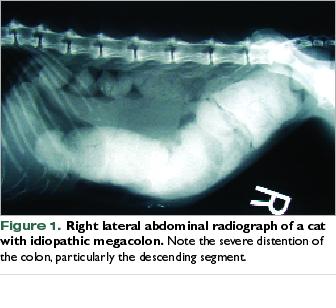
Megacolon in cats. Abdominal x-ray.
Source: http://d1uhp0uy75me04.cloudfront.net/mmah/d1/334e3ae79b4ddc85948a8c9619dc92/file/PV_28_09_658_f1.jpg
Prognosis
With early detection and treatment, the vast majority of cases of megacolon in cats have a favourable prognosis and excellent quality of life. Unfortunately, diagnosis often occurs long after constipation first appears, especially in a multiple cat household, or when cats are indoor/outdoor, as in these situations, owners may not be aware of their cat’s normal bowel habits. If the megacolon has been present for greater than four to six months, colonic distention and loss of function may be irreversible; the colon is not able to return to normal function after this extended period of time. In many such cases, surgery to remove all or part of the colon can return the cat’s life to near normal.
Treatment for megacolon in cats
Treatment for obstipation and idiopathic megacolon involves removal of the impacted faeces and medical management to prevent future occurrences. Where medical management is unsuccessful, surgery is performed to remove all or part of the non-functioning colon.
Medical Treatment
For idiopathic megacolon, initial management is usually medical. Often, a combination of dietary modification, laxatives, enemas and/or drugs that enhance colonic motility is effective therapy.
Hospitalisation:
Hospitalisation is typically required in cases of obstipation and megacolon. In hospital, cats will receive intravenous fluid therapy to correct dehydration and electrolyte imbalances. Manual extraction of impacted faeces under general anaesthesia will be performed in cases where enemas and laxatives have been unsuccessful. (Note that enemas should only be given by a veterinarian, and sodium phosphate enemas should never be used, as they are toxic to cats.)
Medication:
There are two types of medication that may be introduced once the faecal mass has been adequately removed: laxatives and prokinetic therapy. Laxatives are substances that loosen stools and increase bowel movements. “Colonic prokinetic agents” are drugs that enhance colonic motility; in other words, they enhance muscular contractions within the wall of the colon and thereby improve the propulsion of the stool through the colon.
Dietary management:
A change of diet is usually recommended to help prevent future episodes of constipation, obstipation and megacolon. In the past, a high fibre diet and/or supplementation with fibre pills was the conventional wisdom in treating megacolon. Nowadays it is accepted that increased fibre in the diet is not usually helpful for cats with chronic constipation or megacolon, and that a high fibre diet can actually exacerbate colonic distention and subsequent symptoms.
A highly digestible, low-residue (low fibre) diet designed to reduce the amount of stool in the colon is now commonly prescribed for cats with megacolon. “Residue” is the undigested food, including fibre, that makes up the bulk of the stool. A diet that is highly digestible will result in less faecal material and fewer, smaller stools; an all-meat diet may be prescribed for this purpose.
Many cats respond well to medical management of megacolon, although some may occasionally require an enema, administered by the vet, to loosen the stool and facilitate excretion.
Surgical Treatment
When medical therapy is no longer effective, surgery to remove the non-functioning portion of the colon is the next course of action. The surgery is usually subtotal colectomy (removal of most, but not all, of the colon), or occasionally a total colectomy (removal of the entire colon).
The long-term prognosis for cats with idiopathic megacolon that undergo subtotal colectomy is fair to good. Surgical treatment of megacolon is challenging and there is a risk of post-operative infection (the colon, containing faeces, is the most bacteria-laden part of the intestinal tract). Some cats may experience diarrhoea for weeks to months after the surgery. Occasionally, cats require a second surgery if not enough colon was removed the first time.
For cats with abnormal narrowing of the pelvis, surgery can be performed to make the pelvic opening wider. Cats with pelvic obstruction secondary to pelvic trauma can be treated by removal of the abnormal pelvic bones (pelvic ostectomy) to allow normal passage of faeces. If the megacolon has been present for an extended time, a colectomy may also be required.
In summary
Megacolon in cats is characterised by a very dilated and distended colon that is impacted with faeces. This relatively common colonic disorder usually occurs idiopathically (without a known cause), secondary to chronic constipation and obstipation. Symptoms may include difficulties in passing stool, decreased appetite, weight loss and abdominal discomfort. Physical examination characteristically reveals a large amount of very firm faeces palpable within the colon. Diagnostic testing is aimed at ruling out underlying causes such as colonic stricture and/or obstruction.
Feline idiopathic megacolon is treated by medical management consisting of dietary modification and administration of laxatives, enemas, and/or prokinetic therapy. Megacolon surgery in cats that fail to respond to medical therapy is usually in the form of a subtotal colectomy. Most cats respondvery well to the surgery; the procedure can return life to near normal for the affected cat. Post-operatively, stools may be looser than normal, but this generally improves with time and dietary modification.
Bow Wow Meow Pet Insurance can help protect you and your cat should an unexpected trip to the vet occur.
-
Find out more about our cat insurance options
-
Get an instant online pet insurance quote


More information
https://www.acvs.org/small-animal/megacolon
https://www.petcoach.co/article/megacolon-and-constipation-in-cats/
https://www.petmd.com/blogs/fullyvetted/2012/aug/megacolon_in_cats-26658
http://www.vetfolio.com/internal-medicine/feline-idiopathic-megacolon





